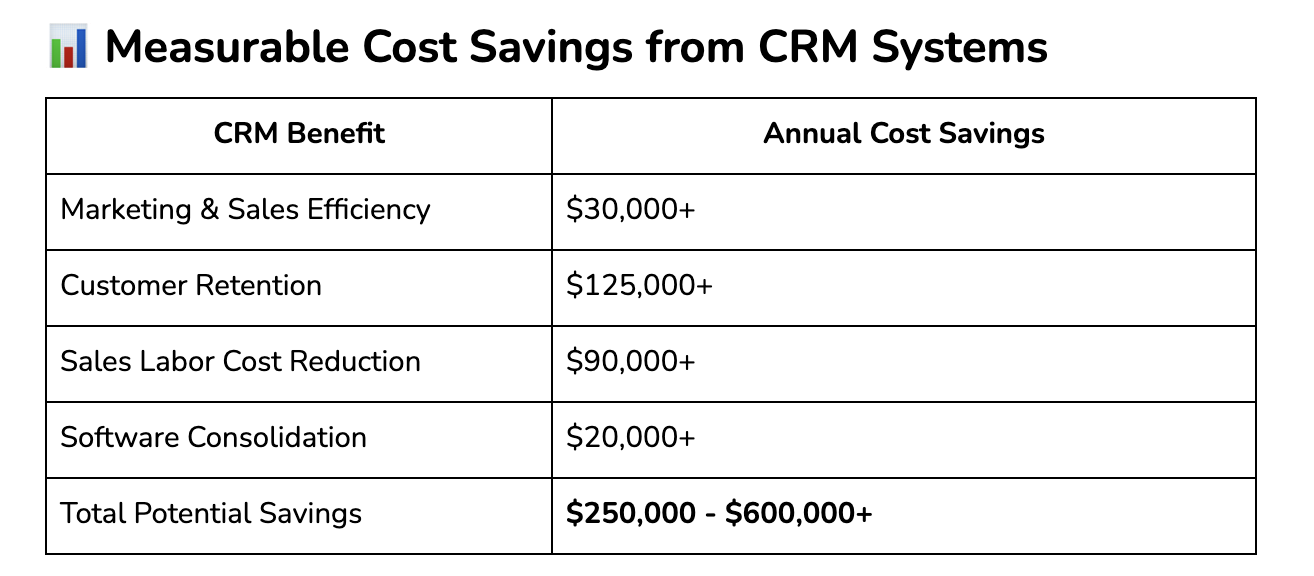Measurable Cost Reduction from ERP & CRM Systems
Businesses adopting Enterprise Resource Planning (ERP) and Customer Relationship Management (CRM) systems see significant cost reductions by optimizing workflows, automating processes, and improving data-driven decision-making. These systems eliminate inefficiencies, reduce labor costs, and enhance revenue opportunities, providing a strong return on investment (ROI).
But what specific cost savings can companies expect? Let’s break it down.
Cost Reduction with ERP Systems
An ERP system integrates business processes like finance, supply chain, HR, and operations into a single platform, reducing duplication, improving efficiency, and cutting operational costs.
1. Labor Cost Savings – Reduce Administrative Work by 20-50%
ERP automates repetitive tasks (payroll, invoicing, procurement), reducing staff workload.
Employees spend less time on data entry and manual coordination.
💡 Example: A company with 5 finance employees spending 40 hours per month on manual invoicing at $30/hour incurs a cost of $6,000/month ($72,000/year). With ERP automation, invoice processing time is cut by 50%, saving $36,000 annually.
2. Inventory & Procurement Cost Savings – Cut Waste by 25-30%
ERP provides real-time inventory tracking, preventing overstocking and shortages.
Automated procurement processes ensure cost-effective supplier selection.
💡 Example: A retail company reducing inventory waste by 25% from a $500,000 annual inventory budget saves $125,000 per year.
3. IT & Software Cost Reduction – Save Up to 40% on Legacy Systems
Consolidating multiple software systems into one ERP platform eliminates redundant software licenses.
Cloud-based ERP solutions eliminate on-premise server maintenance costs.
💡 Example: A company running 5 different systems (finance, HR, inventory, CRM, reporting) at $100,000/year in total software costs can reduce expenses by 40% with a single ERP system, saving $40,000 annually.
4. Downtime & Error Reduction – Minimize Financial Losses
ERP automates data synchronization, reducing errors in payroll, invoices, and orders.
Reduces system downtime from data discrepancies and manual errors.
💡 Example: A company losing $50,000 annually due to order fulfillment errors can reduce mistakes by 80% with ERP, saving $40,000 per year.
Cost Reduction with CRM Systems
A CRM system centralizes customer data, sales tracking, and marketing automation, leading to increased revenue and reduced customer acquisition and retention costs.
1. Sales & Marketing Cost Reduction – Increase Lead Conversion by 30%
CRM automates lead tracking and customer segmentation, reducing wasted marketing spend.
AI-powered CRM insights improve targeting, increasing sales efficiency.
💡 Example: A company spending $100,000/year on marketing with a 5% conversion rate can increase conversion to 6.5% with CRM, generating 30% more revenue from the same budget.
2. Customer Retention Cost Savings – Reduce Churn by 25%
CRM tracks customer interactions and preferences, enabling better support and retention strategies.
Customer churn reduction leads to higher lifetime value (LTV) and lower acquisition costs.
💡 Example: If a business loses $500,000/year in revenue due to churn, reducing churn by 25% saves $125,000 annually.
3. Productivity & Labor Cost Reduction – Save 30-50% on Sales Admin Work
Automated follow-ups, data entry, and reporting reduce manual workload for sales teams.
Sales teams can spend more time closing deals instead of doing paperwork.
💡 Example: A 10-person sales team spending 30% of their time on admin tasks at $60,000 per salesperson incurs a cost of $180,000 annually. CRM reduces admin work by 50%, saving $90,000 per year.
4. IT & Software Savings – Replace Multiple Tools with a Unified CRM
Many businesses use separate tools for email marketing, customer tracking, and sales automation.
A CRM consolidates these functions, reducing software expenses.
💡 Example: A company paying $50,000/year for separate tools can save $20,000 by switching to an all-in-one CRM.
Maximizing ERP & CRM ROI: Best Practices
Cloud-Based Deployment – Lower upfront costs and eliminate expensive infrastructure.
Integration with Existing Tools – Avoid inefficiencies by ensuring seamless data flow.
AI & Automation – Use AI-powered analytics to predict trends and optimize decision-making.
Regular Performance Audits – Continuously monitor and adjust usage to maximize efficiency gains.
Key Takeaways: Why ERP & CRM Drive Business Growth & Cost Reduction
✔ ERP reduces labor, inventory, and IT costs, saving $200,000+ per year.
✔ CRM boosts sales, retention, and productivity, saving $250,000+ per year.
✔ Combined, ERP & CRM drive over $500,000 in annual cost savings while improving efficiency and revenue.
💡 Thinking of implementing ERP or CRM? Let’s design the right strategy for your business to maximize savings!







With years of experience supporting clinics, we help healthcare providers reduce downtime, improve compliance, and focus on what matters most - patient care.